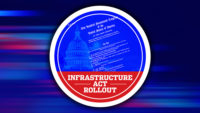While top state transportation officials look and listen for hints about President Trump’s promised, still unreleased infrastructure plan, they are working to cope with more-immediate funding issues.
State departments of transportation are dealing with about $900 million less in federal highway aid this year than they expected because a stopgap spending measure failed to include a 2017 hike authorized by the 2015 Fixing America’s Surface Transportation (FAST) Act.
Looking further ahead, state DOTs are carefully watching the Trump administration’s plans to slice nondefense spending for fiscal year 2018, which begins on Oct. 1, 2017. They are hopeful that core Highway Trust Fund-supported highway and transit accounts will be shielded from the proposed cut. However, other DOT programs are more vulnerable.
The outlook for regaining the FAST Act’s $900 million this year isn’t bright, says Brian Deery, senior director of the Associated General Contractors of America’s highway and transportation division. “I think we’re going to lose that money for fiscal year ’17,” he says. Congress at least must pass a spending extension by April 28, when the current stopgap expires.
To avoid canceling projects, some states have used their own funds and a tool called “advance construction,” which lets them proceed with projects even though those projects lack full federal obligation authority. But Colorado DOT Executive Director Shailen Bhatt says, “Our flexibility is not endless.” He adds, “We’re looking at our cash ‘burn rate’ and saying, ‘Here are some things we can afford to do,’ and then there are other things where we’re just going to have to say, ‘Hey, until we get funding certainty, they’re going to have to wait.’ ”
The 2017 shortfall has yet to force Maine’s DOT to halt projects. “But it will hit at some point in time if we don’t receive what the FAST Act said,” says Commissioner David Bernhardt. The lack of full FAST Act funds hasn’t caused Michigan DOT to postpone projects, either. But Director Kirk Steudle says, “It can’t go on long without having an impact.”
Trump’s 2018 budget will seek to slash nondefense spending by 10%, or $54 billion, and boost the defense sector by the same amount, Office of Management and Budget Director Mick Mulvaney said on Feb. 27. He didn’t specify how big a hit individual agencies would have to absorb.
Deery says DOT’s trust-fund-backed highway and transit programs aren’t likely to be cut. Given Trump’s emphasis on infrastructure investment, Deery says, “I can’t imagine him … specifically going after Highway Trust Fund funding. I mean, the money’s already there.”
Bhatt is awaiting the Trump budget specifics for DOT but says he is “incredibly worried” about the possible impact on non-trust-fund programs. Some are tremendously popular in both red and blue states, especially TIGER grants and the two-year-old FASTLANE grants for highway and freight-related projects. Steudle says, “There’s always a potential [for cuts], but I see more money going into transportation than going out.” He says, “The bread-and-butter [trust-fund] stuff that we really depend on, I think is going to be there, if not increased.”
Trump’s still undrafted $1-trillion, 10-year infrastructure plan was also a subject of discussion for the DOT leaders who met in Washington, D.C., on Feb. 28-March 3 for the American Association of State Highway and Transportation Officials winter conference.
Trump on Feb. 28 told Congress, “The time has come for a new program of national rebuilding.” U.S. DOT Secretary Elaine Chao on March 1 told AASHTO officials, “We’ve had numerous meetings at the White House and at the Dept. of Transportation with key infrastructure stakeholders from all over the country” on a rebuilding package. But the process clearly is in its early days.
Private-sector dollars will be a part of the plan, say Chao and House Transportation and Infrastructure Committee Chairman Bill Shuster (R-Pa.). Shuster told the AASHTO members, “It’s not going to be a trillion dollars coming out of Washington, D.C.” But he said there will be increased federal funding, too. Shuster said that, to gain political support, the plan should contain projects all around the country. “It’s got to be a 50-state solution,” he said, perhaps including “something like 500” projects.
William Panos, Wyoming DOT director, says, “I think all of our states are ready to move forward with that kind of an agenda.” He adds, “Certainly, anything that all of the states, including the rural states, can take advantage of is what we’re interested in.”
State DOT leaders are not counting on dollars from the Trump proposal anytime soon, however. “It’s not in our financial models for this year,” says Michael Holder, North Carolina DOT chief engineer. He adds, “Given the pace of things, I would anticipate that it would be sometime in ’18 before we see anything from that.” Meanwhile, the agency is getting ready “by continuing to accelerate design and planning,” Holder says.
Greg Bailey, West Virginia DOT acting state highway engineer, praises the bipartisan pro-infrastructure comments. He says, “Ultimately, we’ll need to know the details of how all this gets put together, but it’s just a huge benefit to have everybody talking about actually doing something for the infrastructure.”



